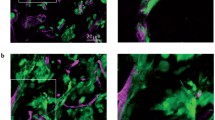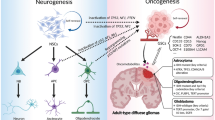Abstract
Local invasion of the brain by neoplastic glial cells is a major obstacle to effective treatment of intrinsic brain tumors. Invasion is directly related to histologic malignancy, but occurs to some extent irrespective of tumor grade. Because the brain-to-tumor interface is not well demarcated, total surgical removal is rarely possible; moreover, as invading cells transiently arrest from cell division they are refractory to radiotherapeutic intervention. Invading cells may also be protected from the action of cytotoxic drugs by the presence of an intact blood-brain barrier. The invading cells, having migrated several millimeters or even centimeters from the main focus of the tumor, return to cycle phase under the control of some as yet unknown microenvironmental cue to form a recurrent tumor adjacent to the original site of presentation. Recent cellular and genetic information concerning factors underlying invasion may not only yield suitable targets for adaptation of existing therapies, but may also lead to novel approaches in glioma management.
Similar content being viewed by others
References and Recommended Reading
Radhakrishnan K, Bohnen NI, Kurland LT: Epidemiology of brain tumors. In Brain Tumors: A Comprehensive Text. Edited by Morantz RA, Walsh JW. New York: Marcel Dekker; 1994:1–18.
Legler JM, Gloeckler Reis LA, Smith MA, et al.: Brain and other central nervous system cancers: Recent trends in incidence and mortality. J Natl Cancer Inst 1999, 91:1382–1390.
Pilkington GJ: Glioma heterogeneity in vitro: the significance of growth factors and gangliosides. Neuropathol Appl Neurobiol 1992, 18:434–442.
Pilkington GJ: Tumour cell migration in the central nervous system. Brain Pathol 1994, 4:157–166.
Pilkington GJ: The role of the extracellular matrix in neoplastic glial invasion of the nervous system. Brazilian J Med Biol Rese 1996, 29:1159–1172.
Maidment SL, Rucklidge GJ, Rooprai HK, et al.: An inverse correlation between expression of NCAM-A and the matrixmetalloproteinases gelatinase-A and gelatinase-B in human glioma cells in vitro. Cancer Lett 1997, 116:71–77.
Gratsa A, Rooprai HK, Rogers JP, et al.: Correlation of expression of NCAM and GD3 ganglioside to motile behaviour in neoplastic glia. Anticancer Res 1997, 17:4111–4117.
Merzak A, McCrea S, Koochekpour S, et al.: Control of human glioma cell growth, migration and invasion in vitro by transforming growth factor B1. Br J Cancer 1994, 70:199–203.
Sehgal A, Ricks S, Warrick J, et al.: Antisense human neuroglia related cell adhesion molecule hNr-CAM, reduces the tumorigenic properties of human glioblastoma cells. Anticancer Res 1999, 19:4947–4953.
Paulus W, Tonn JC: Basement-membrane invasion of glioma cells mediated by integrin receptors. J Neurosurg 1994, 80:515–519.
Rooprai HK, Vanmeter T, Panou C, et al.: The role of integrin receptors in aspects of glioma invasion in vitro. Int J Dev Neurosci 1999, 17:613–623.
Merzak A, Koochekpour S, Pilkington GJ: Adhesion of human glioma cell lines to fibronectin, laminin, vitronectin and collagen I is modulated by gangliosides in vitro. Cell Adhes Commun 1995, 3:27–43.
Merzak A, Koochekpour S, McCrea S, et al.: Gangliosides modulate proliferation, migration, and invasiveness of human brain tumor cells in vitro. Mol Chem Neuropathol 1995, 24:121–135.
Koochekpour S, Merzak A, Pilkington GJ: Growth factors and gangliosides stimulate laminin production by human glioma cells in vitro. Neurosci Lett 1995, 186:53–56.
Maidment SL, Merzak A, Koochekpour S, et al.: The effect of exogenous gangliosides on matrix metalloproteinase secretion by human glioma cells in vitro. Eur J Cancer 1996, 32:868–871.
Koochekpour S, Merzak A, Pilkington GJ: Vascular endothelial growth factor production is stimulated by gangliosides and TGF-beta isoforms in human glioma cells in vitro. Cancer Lett 1996, 102:209–215.
Merzak A, Koochekpour S, Dkhissi F, et al.: Synergism between growth factors in the control of glioma cell proliferation, migration and invasion in vitro. Int J Oncol 1995, 6:1079–1085.
Rutka JT, Ivanchuk S, Mondal S, et al.: Co-expression of nestin and vimentin intermediate filaments in invasive human astrocytoma cells. Int J Dev Neurosci 1999, 17:503–515. Important study.
Steck PA, Pershouse MA, Jasser SA, et al.: Identification of a candidate tumour suppressor gene, MMAC1, at chromosome 10q23.3 that is mutated in multiple advanced cancers. Nature Genet 1997, 15:356–362.
Li J, Yen C, Liaw D, et al.: PTEN, a putative protein tyrosine phospatase gene mutated in human brain, breast, and prostatic cancer. Science 1997, 275:1943–1947.
Maier D, Jones G, Li X, Schonthal AH, et al.: The PTEN lipid phosphatase domain is not required to inhibit invasion of glioma cells. Cancer Res 1999, 59:5479–5482.
Merzak A, Koochekpour S, Pilkington GJ: CD44 mediates human glioma cell adhesion and invasion in vitro. Cancer Res 1994, 54:3988–3992.
Okada H, Yoshida J, Sokabe M, et al.: Suppression of CD44 expression decreased migration and invasion of human glioma cells. Int J Cancer 1996, 66:255–260.
Breyer R, Hussein S, Radu DL, et al.: Disruption of intracerebral progression of C6 rat glioblastoma by in vivo treatment with anti-CD44 monoclonal antibody. J Neurosurg 2000, 92:140–149. Authors conclude that CD44-targeted treatment with specific mAb may represent an effective means for preventing progression of invasive gliblastoma mulitformes.
Okamoto I, Kawano Y, Matsumoto M, et al.: Regulated CD44 cleavage under the control of protein kinase C, calcium influx, and the Rho family of small G proteins. J Biol Chem 1999, 274:25525–25534.
Lane RP, Chen XN, Yamakawa K, et al.: Characterization of a highly conserved human homolog to the chicken neural cell surface protein bravo/NrCAM that maps to chromosome band 7q31. Genomics 1996, 35:456–465.
Sehgal A, Boynton AL, Young RF, et al.: Cell adhesion molecule Nr-CAM is over-expressed in human brain tumors. Int J Cancer 1998, 76:451–458.
Sehgal A, Ricks S, Warrick J, et al.: Antisense human neuroglia related cell adhesion molecule hHr-CAM, reduces the tumorigenic properties of human glioblastoma cells. Anticancer Res 1999, 19:4947–4953.
Bouterfa H, Darlapp AR, Klein E, et al.: Expression of different extracellular matrix components in human brain tumor and melanoma cells in respect to variant culture conditions. J Neurooncol 1999, 44:23–33.
Jung S, Hinek A, Tsugu A, et al.: Astrocytoma cell interaction with elastin substrates: implications for astrocytoma invasive potential. Glia 1999, 25:179–189.
Hagel C, Stavrou DK: CD44 expression in primary and recurrent oligodendrogliomas and in adjacent gliotic brain tissue. Neuropathol Appl Neurobiol 1999, 25:313–318.
Forsyth PA, Wong H, Laing TD, et al.: Gelatinase-A (MMP-2), gelatinase-B (MMP-9) and membrane type matrix metalloproteinase-1 (MT1-MMP) are involved in different aspects of the pathophysiology of malignant gliomas. Br J Cancer 1999, 79:1828–1835. Data suggest that gelatinase-A and -B and MT1-MMP are important in the pathophysiology of human gliomas.
Nakada M, Nakamura H, Ikeda E, et al.: Expression and tissue localization of membrane-type 1, 2, and 3 matrix metalloproteinases in human astrocytic tumors. Am J Pathol 1999, 154:417–428.
Qin H, Sun Y, Benveniste EN: The transcription factors Sp1, Sp3, and AP-2 are required for constitutive matrix metalloproteinase-2 gene expression in astroglioma cells. J Biol Chem 1999, 274:29130–29137.
Velasco G, Cal S, Merlos-Suarez A, et al.: Human MT6-matrix metalloproteinase: identification, progelatinase A activation, and expression in brain tumors. Cancer Res 2000, 60:877–882.
Rooprai HK, Rucklidge GJ, Panou C, et al.: The effects of exogenous growth factors on matrix metalloproteinase secretion by human brain tumour cells. Br J Cancer 2000, 82:52–55.
Kitange G, Kishikawa M, Nakayama T, et al.: Expression of the Ets-1 proto-oncogene correlates with malignant potential in human astrocytic tumors. Mod Pathol 1999, 12:618–626.
Kitange G, Shibata S, Tokunaga Y, et al.: Ets-1 transcription factor-mediated urokinase-type plasminogen activator expression and invasion in glioma cells stimulated by serum and basic fibroblast growth factors. Lab Invest 1999, 79:407–416.
Tonn JC, Kerkau S, Hanke A, et al.: Effect of synthetic matrix-metalloproteinase inhibitors on invasive capacity and proliferation of human malignant gliomas in vitro. Int J Cancer 1999, 80:764–772.
Chintala SK, Fueyo J, Gomez-Manzano C, et al.: Adenovirusmediated p16/CDKN2 gene transfer suppresses glioma invasion in vitro. Oncogene 1997, 15:2049–2057.
Demchik LL, Sameni M, Nelson K, et al.: Cathepsin B and glioma invasion. Int J Dev Neurosci 1999, 17:483–494.
Mai J, Finley RL Jr, Waisman DM, et al.: Human procathepsin B interacts with the annexin II tetramer on the surface of tumor cells. J Biol Chem 2000, 275:12806–12812.
Mohan PM, Chintala SK, Mohanam S, et al.: Adenovirusmediated delivery of antisense gene to urokinase-type plasminogen activator receptor suppresses glioma invasion and tumor growth. Cancer Res 1999, 59:3369–3373.
Novak U, Stylli SS, Kaye AH, et al.: Hyaluronidase-2 overexpression accelerates intracerebral but not subcutaneous tumor formation of murine astrocytoma cells. Cancer Res 1999, 59:6246–6250.
Lamszus K, Laterra J, Westphal M, et al.: Scatter factor/hepatocyte growth factor (SF/HGF) content and function in human gliomas. Int J Dev Neurosci 1999, 17:517–530.
Welch WC, Kornblith PL, Michalopoulos GK, et al.: Hepatocyte growth factor (HGF) and receptor (c-met) in normal and malignant astrocytic cells. Anticancer Res 1999, 19:1635–1640.
Moriyama T, Kataoka H, Koono M, et al.: Expression of hepatocyte growth factor/scatter factor and its receptor c-Met in brain tumors: evidence for a role in progression of astrocytic tumors [review]. Int J Mol Med 1999, 3:531–536.
Mueller MM, Herold-Mende CC, Riede D, et al.: Autocrine growth regulation by granulocyte colony-stimulating factor and granulocyte macrophage colony-stimulating factor in human gliomas with tumor progression. Am J Pathol 1999, 155:1557–1567.
Miyake K, Kimura S, Nakanishi M, et al.: Transforming growth factor-beta1 stimulates contraction of human glioblastoma cell-mediated collagen lattice through enhanced alpha2 integrin expression. J Neuropathol Exp Neurol 2000, 59:18–28.
Khoshyomn S, Lew S, DeMattia J, et al.: Brain tumor invasion rate measured in vitro does not correlate with Ki-67 expression. J Neurooncol 1999, 45:111–116.
Chekenya M, Rooprai HK, Davies D, et al.: The NG2 chondroitin sulfate proteoglycan: role in malignant progression of human brain tumours. Int J Dev Neurosci 1999, 17:421–435.
Author information
Authors and Affiliations
Rights and permissions
About this article
Cite this article
Bolteus, A.J., Berens, M.E. & Pilkington, G.J. Migration and invasion in brain neoplasms. Curr Neurol Neurosci Rep 1, 225–232 (2001). https://doi.org/10.1007/s11910-001-0022-x
Issue Date:
DOI: https://doi.org/10.1007/s11910-001-0022-x




